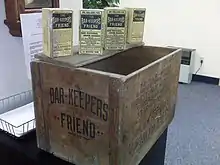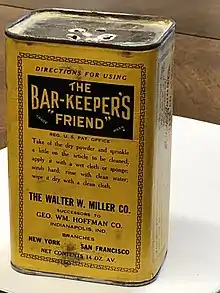Bar Keepers Friend
Bar Keepers Friend is a brand of mass-produced cleaning agents. The original canned scouring powder product has been manufactured and sold since 1882.[3] It was invented by a chemist in Indianapolis, Indiana, where it continues to be manufactured by SerVaas Laboratories.[4][5] The canned product's primary active ingredient is oxalic acid. Bar Keepers Friend has various cleaning uses.
 The Bar Keepers Friend logo, designed to resemble saloon doors | |
 A can of Bar Keepers Friend in 2010, with English and Spanish text | |
| Product type | Powdered cleaning agent, liquid and spray cleansers |
|---|---|
| Owner | SerVaas Laboratories, Inc. (1957–present)[1] |
| Produced by | SerVaas Laboratories, Inc. |
| Country | United States |
| Introduced | 1882 |
| Markets | United States, Canada, United Kingdom[2] |
| Website | www |
Overview
Bar Keepers Friend was originally manufactured in 1882 as a cleaning agent in powdered form. This formulation is still manufactured today. It was invented by chemist George William Hoffman in Indianapolis, Indiana. The product was originally sold to bars in Indianapolis and Hoffman asserted in a patent application that the name had been used since January, 1887.[6][7] The formula contains oxalic acid as a primary ingredient.[8][9]
The Bar Keepers Friend logo represents the swinging doors of a saloon.[10] According to the president of SerVaas Laboratories, Paul SerVaas, although some people complained during Prohibition, "the name was never changed. It's been Bar Keepers Friend since 1882".
In the 1950s the product became the base of a line of cleaning products made by Indianapolis-based SerVaas Laboratories,[1] which started producing and carrying products under the Bar Keepers Friend brand name. Additional products manufactured and marketed under the Bar Keepers Friend brand name include liquid, cream and spray cleaners.[11][12] SerVaas Laboratories had 40 employees in May 2011[1] and 54 in April 2016.[4]
Production
Bar Keepers Friend products are mass-produced in a manufacturing environment that has significant automation in the process.[3] The powdered and canned (original) product is formulated in separate two-ton batches during the production process.[3] In September 2016, the canned powdered product was manufactured at a rate of approximately 60,000 cans per day, which are packaged in 12, 15 and 21 ounce cans.[3]
Active ingredients
According to the 2015 material safety data sheet, the ingredients are feldspar, linear sodium dodecyl benzene sulfonate (DDBSA) and oxalic acid.[13] Prolonged use and extended skin contact may cause irritation,[13] peeling and contact dermatitis, which is avoided by wearing gloves. The product can also be an eye irritant.[13]
Performance and uses
In 1994, Consumer Reports found Bar Keepers Friend to perform on a par with Mr. Clean for removing baked-on soil, tea stains and other pot stains, and that it was better at removing rust.[14] While recommending Bar Keepers Friend for a variety of household cleaning uses, author Heather Solos warned that it should not be used to clean silverware, pewter or real marble.[15]
The product serves to make stainless steel resistant to oxidation via the process of passivation and can remove rust on stainless steel.[16] The product can also remove small scratches from stainless steel,[17] silver and plates.[18]

Uses of Bar Keepers Friend that are not noted on its label include removing hard water stains from glass and windows[19] and removing the brown or yellow stains caused by sunscreen containing avobenzone. The product can also clean teak wood and serves to bleach it.[20][21]


See also
References
- Schouten, Cory (May 12, 2011). "Bar Keepers Friend parent lands new headquarters". Indianapolis Business Journal. Retrieved July 6, 2012.
- "Bar Keepers Friend back to clean up UK". The Grocer. November 1, 2012. Retrieved February 28, 2017. (subscription required)
- Reynolds, Pat (September 16, 2016). "Accuracy improved in auger filling". Packaging World. Retrieved February 28, 2017.
- "Maker of Indy mainstay Bar Keepers Friend plans expansion". Indianapolis Business Journal. April 18, 2016. Retrieved February 28, 2017.
- "The Bar Keepers Friend Story". Barkeepersfriend.com. Retrieved July 6, 2012.
- "Sunday Adverts: George William Hoffman Co. (Bar-Keepers' Friend)". Historic Indianapolis. 2014-05-04. Retrieved 2017-04-25.
- Patent Office, United States (1889). "Official Gazette of the United States Patent Office". 49 (13): 1849. Retrieved 2015-03-30. Cite journal requires
|journal=(help) - Hunt, Mary (February 10, 2016). "Mary Hunt: Three generic cleaners same as brand names but cheaper". Herald-Review. Retrieved February 28, 2017.
- Wiseman, G. (2002). Nutrition and Health. Taylor & Francis. p. 67. ISBN 978-0-415-27875-1. Retrieved February 28, 2017.
- "About Us". Bar Keepers Friend. February 28, 2017. Retrieved February 28, 2017.
- The Good Housekeeping Institute (March 20, 2013). "Bar Keepers Friend Cooktop Cleaner Review". Good Housekeeping. Retrieved February 28, 2017.CS1 maint: ref=harv (link)
- "Our Cleaning Products". Bar Keepers Friend. February 28, 2017. Retrieved February 28, 2017.
- "Safety Data Sheet" (PDF). Servaas Laboratories. December 2015. Retrieved December 22, 2016.
- Indiana Business Magazine, Friday, April 1, 1994
- Home-Ec 101: Using Bar Keepers Friend, February 18, 2009
- Schaefer, M. (2014). The Homebrewer's Handbook: An Illustrated Beginner's Guide. Skyhorse Publishing. p. pt145. ISBN 978-1-62914-989-9.
- Dominguez, J.M. (2015). The Holy Grail Maintenance: Maintenance Reference Guide. Page Publishing. pp. pt191-192. ISBN 978-1-68139-095-6.
- Custer, D. (2010). Food Styling: The Art of Preparing Food for the Camera. John Wiley & Sons. ISBN 978-0-470-08019-1. Retrieved February 28, 2017.
- Romero, Cristel (August 13, 2015). "7 products to make cleaning your home quick and easy". Las Vegas Review-Journal. Retrieved February 28, 2017.CS1 maint: ref=harv (link)
- Badham, M.; Robinson, R.; Badham, M. (1999). Sailors' Secrets. McGraw-Hill Education. p. 56. ISBN 978-0-07-134869-0.
- Unger, B.; Sovchen, D. (1999). Absolute power trip: lifestyle guide for women boaters. Greenleaf Enterprises. p. 57. ISBN 978-0-9665319-4-7.
Further reading
- Hibbs, Bill (January 17, 2009). "Bar Keepers Friend is also bathtub pal". St. Louis Post Dispatch. Retrieved July 6, 2012.
- "Bar Keepers Friend". Indiana Business Magazine. April 1, 1994. Archived from the original on March 1, 2017. Retrieved July 6, 2012. (subscription required)
External links
- Official website
- Pollard, Garland (December 6, 2008). "Bar Keepers Friend, One of Many Great Hoosier Brands". BrandlandUSA. Retrieved July 6, 2012.